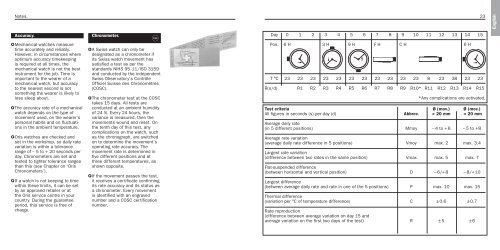Create successful ePaper yourself
Turn your PDF publications into a flip-book with our unique Google optimized e-Paper software.
Notes.<br />
Accuracy.<br />
Mechanical watches measure<br />
time accurately and reliably.<br />
However, in circumstances where<br />
optimum accuracy timekeeping<br />
is required at all times, the<br />
mechanical watch is not the best<br />
instrument for the job. Time is<br />
important to the wearer of a<br />
mechanical watch, but accuracy<br />
to the nearest second is not<br />
something the wearer is likely to<br />
lose sleep about.<br />
The accuracy rate of a mechanical<br />
watch depends on the type of<br />
movement used, on the wearer’s<br />
personal habits and on fluctuations<br />
in the ambient temperature.<br />
<strong>Oris</strong> watches are checked and<br />
set in the workshop, so daily rate<br />
variation is within a tolerance<br />
range of – 5 to + 20 seconds per<br />
day. Chronometers are set and<br />
tested to tighter tolerance ranges<br />
than this (see Chapter on ‘<strong>Oris</strong><br />
Chronometers’).<br />
If a watch is not keeping to time<br />
within these limits, it can be set<br />
by an approved retailer or at<br />
the <strong>Oris</strong> service centre in your<br />
country. During the guarantee<br />
period, this service is free of<br />
charge.<br />
Chronometer.<br />
D<br />
A Swiss watch can only be<br />
designated as a chronometer if<br />
its Swiss watch movement has<br />
satisfied a test as per the<br />
standards NIHS 95-11/ISO 3159<br />
and conducted by the independent<br />
Swiss Observatory’s Contrôle<br />
Officiel Suisse des Chronomètres<br />
(COSC).<br />
The chronometer test at the COSC<br />
takes 15 days. All tests are<br />
conducted at an ambient humidity<br />
of 24 %. Every 24 hours, the<br />
variance is measured, then the<br />
movements wound and reset. On<br />
the tenth day of this test, any<br />
complications on the watch, such<br />
as the chronograph, are switched<br />
on to determine the movement’s<br />
operating rate accuracy. The<br />
movement rate is determined in<br />
five different positions and at<br />
three different temperatures, as<br />
shown opposite.<br />
If the movement passes the test,<br />
it receives a certificate confirming<br />
its rate accuracy and its status as<br />
a chronometer. Every movement<br />
is identified with an engraved<br />
number and a COSC certification<br />
number.<br />
Day 0 1 2 3 4 5 6 7 8 9 10 11 12 13 14 15<br />
Pos. 6 H 3 H 9 H F H C H 6 H<br />
T °C 23 23 23 23 23 23 23 23 23 23 23 8 23 38 23 23<br />
R(s/d) R1 R2 R3 R4 R5 R6 R7 R8 R9 R10* R11 R12 R13 R14 R15<br />
23<br />
*Any complications are activated.<br />
Test criteria Ø (mov.) Ø (mov.)<br />
All figures in seconds (s) per day (d) Abbrev. > 20 mm < 20 mm<br />
Average daily rate<br />
(in 5 different positions) Mmoy – 4 to +6 – 5 to +8<br />
Average rate variation<br />
(average daily rate difference in 5 positions) Vmoy max. 2 max. 3.4<br />
Largest rate variation<br />
(difference between two rates in the same position) Vmax max. 5 max. 7<br />
Flat-suspended difference<br />
(between horizontal and vertical position) D –6/+8 – 8/+10<br />
Largest difference<br />
(between average daily rate and rate in one of the 5 positions) P max. 10 max. 15<br />
Thermal difference<br />
(variation per °C of temperature difference) C ±0.6 ±0.7<br />
Rate reproduction<br />
(difference between average variation on day 15 and<br />
average variation on the first two days of the test) R ±5 ±6<br />
English









